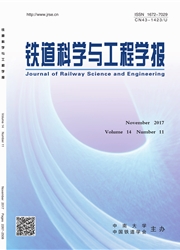

 中文摘要:
中文摘要:
针对刚性系杆拱桥的成桥吊杆索力优化问题,在综述常见的几种索力优化方法基础上,结合具体的工程实例,通过比较分析吊杆索力及其相应的系梁、拱肋弯矩,探讨这些方法在确定刚性系杆拱桥成桥吊杆优化索力上的适用性。研究结果表明:刚性支承连续梁法和零位移法不适用于此类系杆拱桥,内力平衡法和刚性吊杆法不适用于本文的工程实例;弯曲能量最小法和弯矩最小法适用于在初步设计阶段确定此类系杆拱桥的成桥吊杆索力;有约束的弯曲能量最小法适用于在施工图设计阶段和施工监控过程中确定此类系杆拱桥的成桥吊杆索力。
 英文摘要:
英文摘要:
Aiming at the optimum issue of hanger forces for rigid tied-arch bridges at completion stage,some optimum approaches were reviewed and utilized in this paper for determining the optimal hanger forces of a real typical rigid tied-arch bridge. Comparing the hanger forces and corresponding bending moments of tied beam and arch rib,the applicability of these methods for tied-arch bridges was discussed. The research results show that the rigid continuous girder method and the zero displacement method are not suitable for this kind of tied-arch bridge and the internal force equilibrium approach and the stiff hanger method are not applicable for this typical rigid tied-arch bridge used in the paper. Meanwhile,the unconstrained minimum bending strain energy method and the minimum bending moment way are reasonable in the preliminary design stage due to their simplicity and the rationality of computing results. Moreover,the constrained minimum bending strain energy approach is applicable in the working drawing design stage and in the process of construction monitoring since its computing results are more rational than ones determined by those unconstrained methods.
 同期刊论文项目
同期刊论文项目
 同项目期刊论文
同项目期刊论文
 Statistical structural damage detection based on the closed-form of element modal strain energy sens
Statistical structural damage detection based on the closed-form of element modal strain energy sens Time-varying system identification of high voltage switches of a power substation with novel slide-w
Time-varying system identification of high voltage switches of a power substation with novel slide-w Structural damage detection based on stochastic subspace identification and statistic pattern recogn
Structural damage detection based on stochastic subspace identification and statistic pattern recogn Computation of plane crack stress intensity factors using trigonometric wavelet finite element metho
Computation of plane crack stress intensity factors using trigonometric wavelet finite element metho A Hilbert transform method for parameter identification of time-varying structures with observer tec
A Hilbert transform method for parameter identification of time-varying structures with observer tec Time-varying linear and nonlinear structural identification with analytical mode decomposition and H
Time-varying linear and nonlinear structural identification with analytical mode decomposition and H Application of an improved HHT method for modal parameters identification of structures with closely
Application of an improved HHT method for modal parameters identification of structures with closely A synchrosqueezed wavelet transform enhanced by extended analytical mode decomposition method for dy
A synchrosqueezed wavelet transform enhanced by extended analytical mode decomposition method for dy 期刊信息
期刊信息
